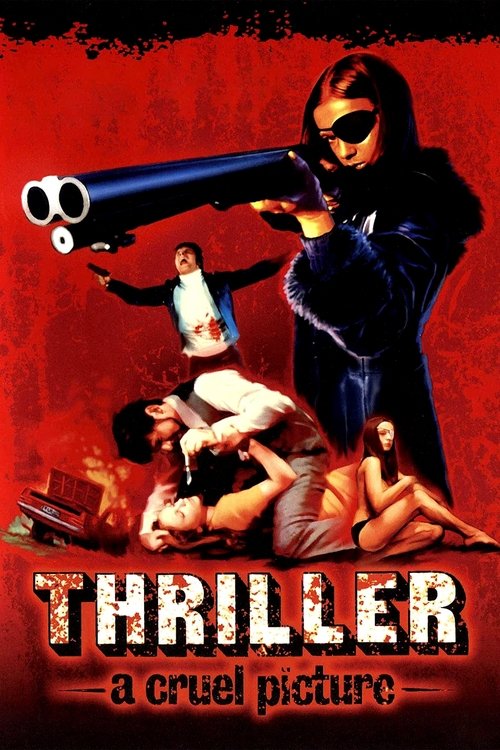Facing financial ruin after Hur Marie träffade Fredrik, a family movie that was received well critically but performed abysmally at the box office, Bo Vibenius declared he would make “the most commercial film ever made” with Thriller: A Cruel Picture. The result is a cheap, quickly made movie with near-fatal pacing problems that leans heavily on shock value to paper over the thinness of the story.
Vibenius’s marketing strategy depended on the film being banned by Swedish authorities, so the original version featured hard-core sex scenes. What got the film banned, though — according to lead actress Christina Lindberg — was the excessive violence. This original version played at Cannes only to disappear for decades. Heavily re-edited versions (released as “They Call Her One-Eye” and several other titles) were finally released in the US and elsewhere. Recently the movie has seen restoration and re-release by the boutique movie labels Synapse and Vinegar Syndrome.
Thriller tells the story of Frigga (Christina Lindberg). Frigga, rendered mute by a sexual assault when she was a young child, goes on a date with Tony (Heinz Hopf) and agrees to come home with him for a nightcap. Once alone, he drugs her, holds her prisoner, and forces heroin on her until she becomes addicted. A rough recruitment strategy to be sure, but one fast-food restaurants are no-doubt considering.

“Of course we’ll work around your class schedule.”
Tony explains to the horrified Frigga that she is now so dependent on heroin that withdrawal symptoms will kill her. She works for him now as a prostitute. When Frigga resists, Tony beats her, then — in one of the movie’s most controversial scenes — cuts out one eye with a scalpel.The scene itself is controversial because it’s apparently not an effect. According to Lindberg, Vibenius shot the scene at a local morgue using the body of a young woman who had died of suicide.
It’s not the only story of unethical production strategies surrounding the movie, but it’s the most upsetting; an extraordinarily low budget meant the working environment was often not safe for the stunt crew, but Vibenius had enough cash to afford a rare extreme-slow-motion camera that chewed through film at a terrifying rate.
Frigga’s compliance thus assured, Tony bizarrely starts paying her a reliable salary and gives her Sundays off. She takes the money and begins martial arts, stunt driving, and marksmanship classes. From here the movie becomes a series of sex scenes interspersed with training montages… until Frigga finally starts hunting down her employers and regular customers.

“OK, give the signal when Tony leaves the Orange Julius.”
An eleven-person team shot Thriller: A Cruel Picture at a breakneck speed, with only 78 days between the first day of shooting and the final sound mix. an eye towards making stacks of cash for a tiny investment, which makes it a pretty solid example of an exploitation film.
Lindberg was already a famous cover-girl and Penthouse model, but she’d been in several movies. Mostly, she says, because of her body — not her acting. Vibenius understood she was not good at line delivery and re-wrote Frigga to be mute, which gave Lindberg more space to concentrate on face acting, which her modeling prepared her for. Even so, Thriller makes only modest demands. Frigga’s two modes are stoic and cold-hearted.

Face acting.
Even for those who speak, Vibenius’s story is so superficial it gives even the speaking actors very little to work with. Everyone’s performance rises above the thinness of the material, which is a low bar indeed, but not one we were guaranteed to cross.
Much of this background information comes from Thriller: A Cruel Documentary. Released with the Vinegar Syndrome restoration, this movie serves as an effective and needed contextualization of the film. Here is also where we also learn that Vibenius rarely cleared his on-location shoots with the proper authorities, resulting in Lindberg being questioned by police for waving a shotgun at passers-by.
Lindberg defends the hardcore scenes as important to the story, claiming they show how degraded Frigga has become and help provide the motivation for her murderous rampage in the final act. Lindberg identifies the performers in these scenes as “Romeo and Julia,” a Stockholm-based live sex nightclub act. The documentary — on which Vibenius has a writing credit — says the intent was to disgust. It does a reasonable job. The brief, clinical, and artless shooting of these scenes bolsters this argument. 1973 was a long time ago, but eroticism in film, even pornography, was not this primitive.

Face acting.
But it’s hard to credit artistic vision to a movie so explicitly and cynically made, especially when Vibenius’s intention was to provoke a media frenzy over a controversial film. Although the film made a splash at Cannes — because of staged promotional bar fights around town and a clever eyepatch gimmick — Lindberg saw nothing beyond her original payout. Neither, apparently, did Vibenius. When Samuel Z. Arkoff picked up world distribution rights, he did so in a way that let him pocket most of the money.

